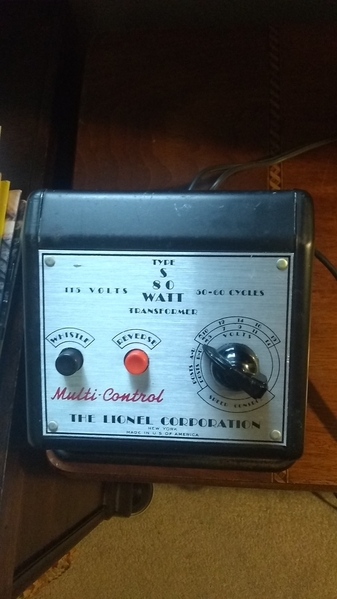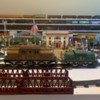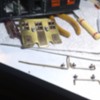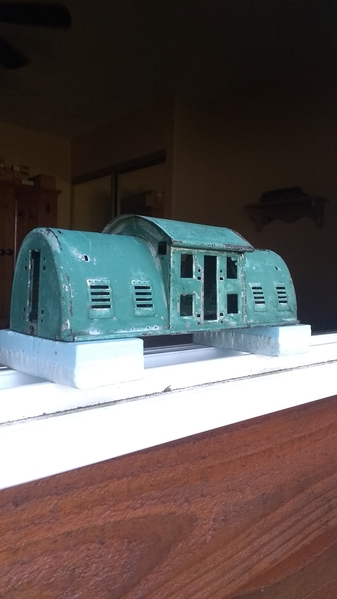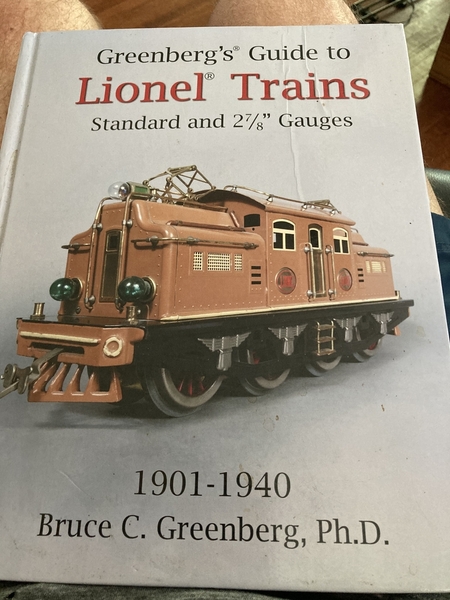 Got my Greenberg guide. Might want to invest in one of these. Pretty much tells the whole story in an organized way. You will learn a lot in a short time, I did.
Got my Greenberg guide. Might want to invest in one of these. Pretty much tells the whole story in an organized way. You will learn a lot in a short time, I did.
Well, it tells the Lionel story (and I *do* want one!), but SG is bigger than Lionel (even if they did start it). Flyer, IVES, Bucher, Bing, and Dorfan all made great trains.
@palallin posted:Well, it tells the Lionel story (and I *do* want one!), but SG is bigger than Lionel (even if they did start it). Flyer, IVES, Bucher, Bing, and Dorfan all made great trains.
... which is why I'm enjoying the Riddle book so much. I kinda think I know the Lionel story (from Hollander's book and others), but this Riddle book seems to be covering all the bases.
Having said that, if I fall far enough into this SG pit, I will probably get the Greenberg book as well... 😁
Mark in Oregon
It’s a valid point that the book is all Lionel, I suppose it depends on where your interest lies. I’m happy to keep my collection small and focused on Lionel prewar standard gauge. I have some nice engines, the small sized passenger sets and 500 freights. Don’t need or want any more at this point. I like having really nice original paint Lionel and I’ll just stay with that for now. I like seeing the other stuff in forum members amazing collections but want to stay small with my own thing.
William 1:
I completely get that; if this mania continues (😜) , I will probably stick to Lionel as well. I do find it interesting to learn about the other brands; some of the American Flyer items are pretty nice!
Different subject: what type of power supply do you SG guys typically use? I just picked up this Type S for a dollar, since the cord was cut:
Have replaced the cord and it works "as advertised". Like probably most of you, I have lots of power packs/transformers, but this is at least kind of an older item... what do you use? 🙂
Mark in Oregon
Attachments
Thanks for your quick response. 🙂
So you are using very "modern" equipment to power your very old trains. That certainly makes sense.
I am reluctant to use any type of transformer as old as these trains; even though the "S" type is anything but new, it's still a lot more recent.
I have a big MRC 027 unit (the one with the handheld) that I might try; the small (also MRC) unit I have seems to work well too.
Like the S scale American Flyer engines, the "33" will do ok on DC, but it seems to take quite a bit of juice to get it running...
More fun and games. 😊
Mark in Oregon
Mark my prewar table is powered by my 250 Watt ZW, which runs my four independent loops. It easily handles the dual motor 408E, along with three other engines and search light cars. Two small transformers supply the lighting circuits.
Attachments
@Rich Wiemann posted:Mark my prewar table is powered by my 250 Watt ZW, which runs my four independent loops. It easily handles the dual motor 408E, along with three other engines and search light cars. Two small transformers supply the lighting circuits.
Wow, that's a lot of stuff going on; those ZWs are pretty powerful, it would seem. 👍
Question: the cars behind the 408E look like they are a little smaller in comparison; what series are they?
Thanks for your response...and terrific video! 🙂
Mark in Oregon
I had a totally equipped TMCC layout and loved it but had to tear it down when I moved. A moment of silence…. Wasn’t interested in Legacy so I sold everything but a few pieces. My dad still has his gray #10 set and he let me have it for a bit and I just thought it was so cool that a 90 year old toy train still looks and runs like new. I guess you could say that’s when I got prewar standard gauge bug. Still have the TMCC power equipment.
@Strummer posted:Question: the cars behind the 408E look like they are a little smaller in comparison; what series are they?
500 Series. Even the 200 might look small behind that.
Mark - Prewar standard gauge freight cars were made in 2 series. The 500 freights are smaller and were included in less expensive sets. The 200 series were larger and included with the bigger engines like the mighty 400E steamer. I have almost every color scheme, not every variation of the 500s. I think there is a tank can or two I don’t have, like the yellow Shell I’ve seen, but I’m pretty happy with what I have and not going after any 200s or the larger sized passenger cars.
@William 1 posted:Mark - Prewar standard gauge freight cars were made in 2 series. The 500 freights are smaller and were included in less expensive sets. The 200 series were larger and included with the bigger engines like the mighty 400E steamer.
Hmm...so the smaller the number, the bigger the car; interesting. So I suppose a "200" series car would look too big for my little "33"...(?)
Thanks for the info and posts so far, guys. This is fascinating stuff...
Mark in Oregon
Mark,
The #33 is an Early Period engine. While it can certainly pull cars from either era, the Classic Period cars (200- and 500-sereis) fit in a little better with the later engines.
Early Period freight cars are the 10-series and the 100-series, with the higher numbered cars also being the smaller in size.
Again, no law forces you to limit your choices, but it is helpful to know what originally came together if you are interested in matching the aesthetics. There was some overlap in sales ca. 1923-4 or 5, including the earlier cars coming with the Classic Era engines. #8 sets with the 30-series passenger cars seem to be kinda common, for example.
@palallin posted:Mark,
The #33 is an Early Period engine. While it can certainly pull cars from either era, the Classic Period cars (200- and 500-sereis) fit in a little better with the later engines.Early Period freight cars are the 10-series and the 100-series, with the higher numbered cars also being the smaller in size.
Again, no law forces you to limit your choices, but it is helpful to know what originally came together if you are interested in matching the aesthetics. There was some overlap in sales ca. 1923-4 or 5, including the earlier cars coming with the Classic Era engines. #8 sets with the 30-series passenger cars seem to be kinda common, for example.
That's all very helpful, thanks. So the #112 gondola (which seems huge to me) is actually one of the smaller series...(?) Holy cow. 😲 So is the #10 engine considered "small" as well?
Mark in Oregon
@Strummer posted:That's all very helpful, thanks. So the #112 gondola (which seems huge to me) is actually one of the smaller series...(?) Holy cow. 😲 So is the #10 engine considered "small" as well?
Mark in Oregon
Mark here is quick side by side comparison between a 408E and 10…..you decide, it’s all relative.
Attachments
@Rich Wiemann posted:
😳😳😳...omigod! That's a 10!?! That's incredible...I had no idea, obviously. No wonder a 408 is so much more expensive and...impressive.
And the curved track for both of these was "042"? Good grief...
Wow, I have a lot to learn; thank you for posting this.
Mark in Oregon
Not all cars can be pulled by all locos (and each MFG has a coupling system) due to size differences... can be a little confusing.
@Rob English posted:Not all cars can be pulled by all locos (and each MFG has a coupling system) due to size differences... can be a little confusing.
You got that right! ![]()
I noticed the over all size of the 112 gondola seems a bit big for the "33"; guess I should look for some smaller freight cars...(?) Is the #10 about the same size as the "33"?
It is "confusing"; at the same time, it also makes it more interesting, in a way.
Mark in Oregon
Here is a document put together some years ago...
Attachments
Thanks Rob.
I hadn't considered the height difference, particularly as it pertains to couplers. 😐
Although "high" and "low" may be open to interpretation, this is generally helpful.
Thanks again; and please bear with me if I ask more questions... which I probably will! 🙂
Mark in Oregon
Regarding transformers. I too have an S that I find is perfect for the test loop we have at our NETCA train meets.
For my home test layout, I use the good old Type Z (checked out by one of our local TCA folk who knows how. That full 25 volts is important for testing older locos, especially SG. You can say that lubrication would avoid that but at times I just want to know the motor does work. I've had cases where the 22 volt ZW just isn't quite enough.
Mainly the pre super-motor motors need a bit more voltage to run. Properly cleaned and lubed Super-motors and BAL motor run well with a zw or similar era xformer
https://ogrforum.ogaugerr.com/...5#161208612824535495
About universal motors, I recently rewired a 42 (dual truck) for a friend. It has a DPDt switch to change between series and parallel. Lionel intended one setting for AC and the other (forget which) for DC. It is the same type of switch as that used for reversing but mounted on the other side of the truck. It's tough getting your fingers and screwdriver into the right configuration to make the connection so I just wired it to be permanently in series, like all of the other engines..
https://ogrforum.ogaugerr.com/...3#162053334069090473
I don't disagree with Rob in his situation, but mine is different. I get some really beat up stuff and at times I want to test before doing all that cleanup work and 25 vs. 22 volts makes a difference. in my case.
@Rob English posted:Mainly the pre super-motor motors need a bit more voltage to run. Properly cleaned and lubed Super-motors and BAL motor run well with a zw or similar era xformer
What's "BAL"...?
Mark in Oregon
Bild-a-Loco (BAL) was Lionel's name for a prewar standard gauge motor whose parts could easily be assembled or disassembled with a screwdriver. The famous #9 in kit form included a BAL motor.
Of course... thank you. 👍
Mark in Oregon
Mark - I would recommend the Greenberg book if you want to learn about these trains. It really does explain a lot. Maybe you can get a lightly used copy cheap. I haven't even opened up the other one yet, but I'll get around to it soon.
Cheers, W!
@mlaughlinnyc posted:https://ogrforum.ogaugerr.com/...3#162053334069090473
I don't disagree with Rob in his situation, but mine is different. I get some really beat up stuff and at times I want to test before doing all that cleanup work and 25 vs. 22 volts makes a difference. in my case.
Makes sense actually. But i really just look for quick electrical function, because overheating is bad. Testing is ok and I do it too. If it won't spin at 18v and 3 amps, something very wrong.
Have begun working on the #10:
As I mentioned elsewhere, "Brasso" is working really well for this project. 😊
Typically, what level of sheen do you use for clear coating the brass pieces? I would guess a "satin"...(?)
Mark (still) in Oregon
Attachments
Is anyone there? 🙂
The work continues; have cleaned and clear coated the brass trim. Turned out really nice, I think. Best of all, only (1) of those little tabs broke; I think it was already "broken", and was being held in place by the paint. I shall be REALLY careful when re-assembling...
I had some "Citrus Strip" on hand, so I thought I would try it. It did a great job on the black "over paint", but barely touched the original "Peacock":
Guess I will be picking up some TSP very soon. 🙂
Got some "donor" #112 gondolas to play with; you guys were right, this Standard Gauge stuff is rather addicting... 😳. I'm enjoying this little foray into SG very much. 😊
Mark in Oregon
Attachments
Strummer,
welcome to the machine that is standard gauge trains. Standard gauge is fun to collect. It’s also a great way to lighten your wallet, unfortunately. But, once you get the hang of repairing and rehabilitating these engines and cars, it’s a little less expensive. Like most everyone here said, once you start, there is not stop. No Matter how hard you try. Standard gauge it’s a rabbit hole that doesn’t end, but it’s a good escape from reality for a while at least.
The link below explains the early 10 series in pretty good detail:
https://www.tinplatetimes.com/...primer/redprimer.htm
Also, there is a Facebook group that covers mostly Standard gauge Lionel and is ran by some notable collectors. Take a look:
https://m.facebook.com/pg/Tinp...nternal&mt_nav=0
a good place to find standard gauge trains is at a train show called “York” it’s hosted in York Pennsylvania. The show is hosted in two intervals, once in August and once in April, for I believe 3 days each.
Some pieces of advice I’d give you is to always make sure to keep your motor clean, bearing’s oiled, and track clean and free of rust or moisture. You always want to make sure to clean off the gunk and oil on your engine, preferably every time you are done running your engines. Also, make sure to clean off your track with a paper towel after running your engines and cars so that all of the possible oil and junk is cleared off. That way your track will stay conducive for years to come. When I clean up my shells and try to shine up the paint, I like to use 3 in one oil. Just use a little and gently rub it in to the paint and she should shine once again. If you do this make sure to be careful with stamps as depending on how old and worn they are, they can rub off fairly easily.
make sure to be extremely careful with zinc pieces and commutators, as these can be the most fragile and almost impossible to repair parts of a engine, car, or accessory. I have some Dorfan accessories made of pure zinc, and I’m afraid to even look at them the wrong way lol. Anyhow, good luck on your adventure into collecting standard gauge!
Trainfam
As perhaps a "post script" to this thread:
The long awaited US track arrived this morning. It looks very nice, like Lionel O gauge track on steroids. One thing that struck me is how big it is; I've been messing around with a few Standard Gauge items, but seeing how big this track is really brings home the mass and size of this stuff. Incredible.
Thanks to Kirk at US Track for his efforts. 🙂
Mark in Oregon
I recently picked up my standard gauge track order from Kirk as well. Let the fun begin.
Thanks to Mark, and our other customers, for patience while we waited for new track parts to be made on our vintage tooling. We were relieved to finally get a partial shipment of ties from the company applying the black oxide finish so we could fill all of the back orders. Chris and I have used 4,000 ties in the last two weeks, and that was just for back orders, not for any shelf stock! We still have an adequate supply to continue filling orders, and hope to have the balance of the 100,000 we stamped sometime soon. Just to be safe we also ordered 100,000 fiber insulators and rolled 100,000 feet of rail, both of which have been delivered. The future looks good for standard gauge track!
Kirk
Gotta add a shameless plug for the Standard Gauge Module Association - we are a small group that is focused on RUNNING our trains on the large layouts that we set up a few times per year. Kirk Lindvig and Chris Bogus, the guys that make USA Track, were founders, I'm current President. We do a breakfast at York twice a year, with a rather significant 'show and tell' of unique standard gauge trains, and do Zoom's with lots of interesting topics quarterly. Our intention is to build the standard gauge community as a vibrant part of the toy train world, and we support the few generous folks that are making new trains and parts to keep 'em running. Membership is free. Contact me and I'll put you on the list.
Jim Waterman
Jim
Email sent...🙂
Mark in Oregon
Yet another question:. 🙂
My little #33 rolls very easily and after shutting off power, it will continue to roll.
The #10, on the other hand, seems to have much more "resistance"; it runs fine, but the wheels are not anywhere near as free rolling as the "33".
Is this a characteristic of the "Super Motor", or am I missing something here? 🤔
Mark in Oregon
Video?





